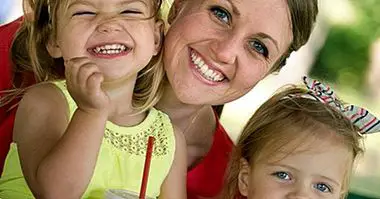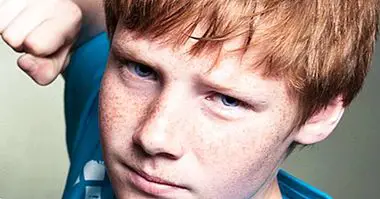5 tips for educators before youth with Non-Suicidal Self-harm
In a study conducted internationally by Brunner et al. (2013), the statistics reflected an average percentage of 27.6% in European students who said they had committed at least one episode of self-harm in their life. Among them, 7.8% had executed more than five actions of this type. The data from the Spanish state indicated a position very similar to the international average (28.9% and 7.6%, respectively), a fact that indicates a significant prevalence of these behaviors so disturbing in our young people.
- Related article: "Non Suicidal Self-injury: Who does it affect and why is it produced?"
Non-Suicidal Self-harm in the educational and school environment
The studies carried out conclude that this type of behavior usually starts between 13 and 14 years and, despite the alarm that may arise from its occurrence, rarely do they directly relate to a clear suicidal ideation . Even so, when a recurrence is observed in this type of actions, the real risk of suicide becomes a higher risk. This is explained because, after a period of habituation to the level of pain that the self-injury leads to the individual, it tends to perform behaviors that give a higher level of pain sensation, thus being able to inflict death in this way ( Straub, 2018).
For all these reasons, its early detection becomes extremely fundamental since this type of actions are usually caused by the experience of intense emotional discomfort and are carried out as a way to alleviate these psychological tensions. In these cases, a relevant role falls on the figure of the young academic educator . It seems indispensable, therefore, to provide this figure with some initial guidelines for action so that the teacher can adequately address this complex and delicate situation.
- You may be interested: "Major depression: symptoms, causes and treatment"
Indicators
There are certain indicators that can alert the educator to the presence of this type of behavior such as: the observation of bodily injuries produced by ambiguous or difficult to explain situations, clothing that is not very consistent with the time of year (long sleeve or high neck in summer), the possession of sharp objects among the personal effects of the children or witnessing sudden and recurrent absences to go to the bathroom during classes.
Advice for educators
These are several guidelines to be followed by educators who deal with youth who present Non-Suicidal Self-harm .
1. Do not judge
A first basic point resides in put aside attitudes of incomprehension, rejection or panic when the adolescent agrees to verbalize the commission of these actions. For the latter, the fact of sharing his experience of emotional distress already becomes an extremely difficult process, so the recommended response as educators should be calm, support, trust and empathy for their insecurities.
The objective of this type of treatment must be that the student understands that he is valued as a person (although not his behavior) and that he perceives that the people in his environment care about him and his well-being. Without resorting to pressure or demand, it is recommended to motivate the young person to seek or access to receive professional help. In approximately half of the cases on which the surveys of the aforementioned investigations are based, it is found that the students wish to abandon this type of behavior and who seem receptive to attending therapy.
- Maybe you're interested: "The 5 types of bullying or bullying"
2. Know how to listen
Secondly, the factors that are motivating these behaviors, as well as their frequency and seriousness, can be addressed directly with the adolescent. This allows assess the referral to a professional who can offer individualized therapeutic assistance and help him acquire psychological strategies to manage his emotions and discomfort in an appropriate and adaptive way.
Questions like: "Have you ever thought about not continuing to live because of some problem that you think has no solution?" Or "Have you ever thought about a specific plan to carry it out?" Can be very helpful in determining the level risk of real suicidal behavior, since usually in non-suicidal self-harm the person does not realistically consider what method to follow to implement this purpose.
3. Do not let the environment reinforce it
Another relevant aspect lies in not reinforce adolescent self-harm behaviors , so the educator should maintain a discreet position regarding classmates and ask the adolescent to keep the wounds covered without giving them excessive importance. This measure prevents the effect of "contagion" of behavior by imitation of other children, potentially frequent in adolescent age groups. Yes, it is convenient, however, to consult the problem with the psychology specialist of the educational center so that it can advise on how to approach the direct approach of the subject before the student.
4. Know the causes and control them
A fourth element to consider lies in the fact that they are family problems, conflicts in the group of friends or difficulties in the school environment The main factors that are associated with a higher frequency of execution of these behaviors. Despite this, it has been observed that a higher probability of real suicide risk is associated with a self-perception of loneliness or isolation, absence of social support and the presence of psychiatric antecedents.
In view of the high risk of suicide, the minor can be referred for therapeutic follow-up in a mental health center. On the contrary, in cases of non-suicidal self-harm behaviors, ambulatory follow-up can be carried out.
5. Apply the appropriate techniques and methods
Finally, although the student in question is carrying out an individual therapeutic follow-up on his part, it is worth mentioning that there are a series of guidelines that may favor a remission of the self-injurious tendency . Thus, meditation and relaxation exercises, disconnection activities such as sports or music, the establishment of alternative action plans for self-injurious behavior or cognitive work on possible distortions when interpreting personal situations are included as effective elements in psychoeducational intervention with these young people.
In conclusion
In-Albon et al. (2015) exhibit a brief action guide for educators that synthesizes what has been exposed up to now. Specifically, the authors indicate the following guidelines as relevant:
- Request medical assistance in case of recent injuries.
- Avoid panic reactions , since in the beginning the risk of real suicide is low.
- Understand behavior as a method to alleviate perceived emotional distress in the short term.
- Offer support, value the person avoiding both critical judgments and pressures for immediate abandonment of self-injurious behavior.
- Address directly if the young person presents real suicidal ideation, investigating the frequency of self-harm and the existence of a plan of premeditated action.
- Motivate the minor to seek psychological help, as well as consult and seek professional advice as an educator to address the situation in an appropriate manner.
Bibliographic references:
- Brunner, R., Kaess, M., Parzer, P., Fischer, G., Carli, V., Hoven, C.W., ... & Balazs, J. (2014). Life-time prevalence and psychosocial correlates of adolescent direct self-injurious behavior: a comparative study of findings in 11 european countries. Journal of Child Psychology and Psychiatry, 55 (4), 337-348.
- Straub, J. (2018) Young, hurt and tired of living? Mind and Brain (90), p.12-17.



















